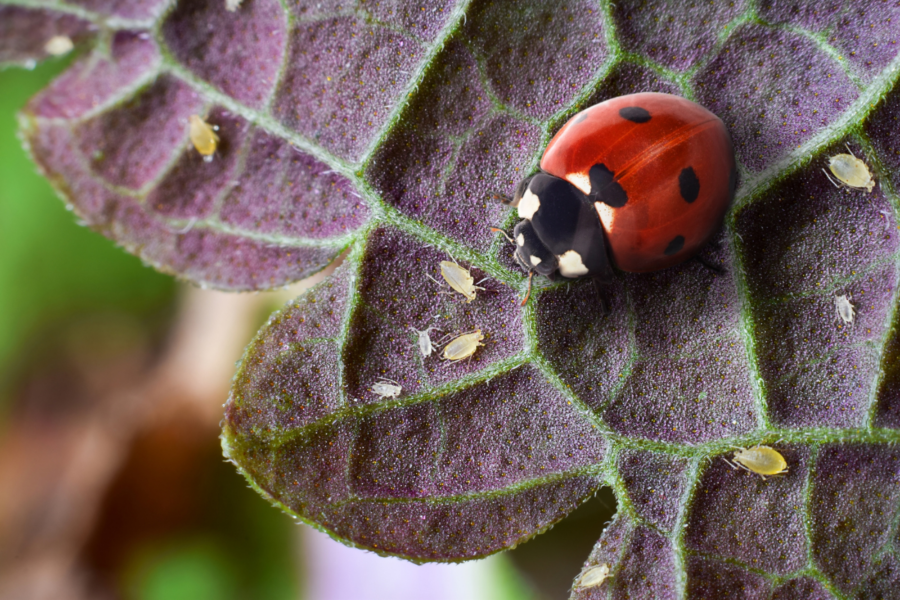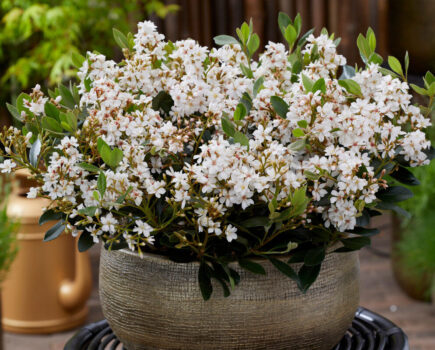Val explains why aphid numbers increase so rapidly and the important role of parasitoid wasps
My daughter Fran has a mad cockapoo called Amber and she is having a problem with dog fleas. Well that’s Amber not Fran. The treatment Fran’s been using for three or four years doesn’t appear to be working anymore. This set me thinking, because the dog fleas have almost certainly built up a resistance to the over-the-counter chemical that’s been routinely applied to Amber’s neck.
Similar things happen in horticulture and agriculture, because living things evolve through natural selection, as Charles Darwin realised. Chemicals that used to be effective get less effective as time moves on. Rothamsted Research Station published an interesting paper about this in 2018. You can look up The evolutionary origins of pesticide resistance, written by Hawkins, Bass, Dixon and Neve on line.

The four scientists concluded that target species are ‘often able to evolve resistance soon after a new compound is introduced’. This leads to ‘rapid evolution under these strong selective pressures’. I think it’s worth explaining why this ‘rapid revolution’ happens in layman’s terms. Aphids reproduce quickly, as any gardener will tell you! Turn a blind eye and a small number will soon turn into a colony. It’s because wingless adult female aphids can produce 50 to 100 offspring. A newly born aphid becomes a reproducing adult within about a week and then they can produce up to five offspring per day for up to 30 days.
I often quote a French naturalist, so forgive me if you’ve read this before. René Réaumur, writing during the late 18th century, calculated that if all the descendants of a single aphid survived during the summer and were arranged into a French military formation, four abreast, their line would extend for 27,950 miles, which exceeds the circumference of the Earth at the Equator!’ In other words, aphids are masters of super-fast reproduction.
The reason aphids are so successful at breeding is simple. They do not have to find a mate in order to reproduce. Their eggs are already in position inside their bodies and these eggs do not need to be fertilised. They’re primed to go, a process defined as parthenogenesis. Pippa Greenwood, a plant pathologist and gardening celebrity, likens the process to a series of Russian dolls. That’s a good analogy and I wish I’d thought of it!
It’s not just about speedy breeding however. Baby aphids are clones of their ‘mother’, so a resistant aphid passes on the same resistance to all their offspring. This allows them to become resistant quickly, so spraying your aphids isn’t always effective. They adapt to the chemical. You are better to rely on natural predators instead. However, if you spray your aphids with soft soap, a branded product or garlic spray, you kill all your soft-bodied creatures and that includes your natural predators. Your resistant aphids are likely to proliferate more.

There’s another problem. Aphid reproduction is very different to conventional pregnancy, which involves two parents who go on to produce genetically variable offspring. If I look at my two daughters and four grandchildren, for instance, they don’t look all that similar and none of them look much like me. Their personalities are equally diverse. They certainly aren’t clones of me, so if I had some resistance to a certain chemical I wouldn’t pass straight it down the line. They may, or may not, inherit it.
The natural world is amazingly complex and we should keep it that way. Keep an eye out for sulphur-yellow, cotton-wool like blobs at this time of year. They’re often found in nooks and crannies. These are the cocoons of Cotesia glomerata, a small parasitoid wasp that attacks large cabbage white and small cabbage butterflies. I have seen this tiny, fly-like wasp at work in my garden, laying eggs into newly-hatched cabbage white caterpillars. They attack them before the large white caterpillars disperse, even though the caterpillars are still tiny.
One newly-hatched and freshly-mated female can lay between 150 and 200 eggs in her 15-day lifespan. She will still manage to lay 16 – 52 eggs within each caterpillar, despite its diminutive size. She will move from one to another and this takes her some time. I was able to watch and take rather grainy pictures of the wasp’s egg-laying process several years ago.

Parasitoid wasps destroy their hosts, because their larvae hatch from eggs laid inside the host’s bodies. The larvae hatch and feed on the soft tissues. Cotesia glomerata is easily spotted. Fifteen days later the larvae emerge and spin yellow cocoons in a cluster on, or nearby, the host caterpillar. After 7 to 10 more days the adult wasps hatch from these cocoons. The whole process takes between 22 and 30 days, from egg to adult. It’s quite gory, because the caterpillar’s body ruptures and tiny wriggly things emerge from the cocoon cases. The males appear before the females and you’ll see more evidence of them in late-summer, because numbers build up as the year progresses. The female wasp looks more like a dark fly.
These parasitoid wasps help to clear up a real nuisance for us. However, if the adults or their larvae come into contact with insecticides they perish. Netting your brassicas helps to prevent the cabbage white problem, mostly, although some of them are related to Houdini and somehow find their way through.
Top Tip
If aphids are really troubling you, pinch the affected shoots off or rub them away with your fingers. The latter breaks their fragile feeding tubes.
Find more tips, advice and articles like this at the Amateur Gardening website. Subscribe to Amateur Gardening magazine now.





